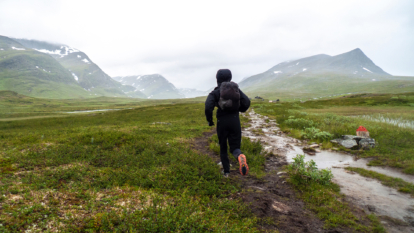The 150-Mile Test
Listen to the story
Words by Eric Noll as told to Ariella Carpenter
All photos by Eric Noll
When the caretaker at Pårtestugan hut saw our tiny running packs, she was concerned. My partner, Dani, and I had stopped for lunch, half a day and 10 miles into the Swedish backcountry. Our plan was to make it to the next hut—13 miles away—by nightfall. We’d also need to ferry across a 1.2-mile-wide lake to get there. Did we know there was a storm coming in with strong winds on the rise? Boats dock early when weather like that whips up.
Optimism and fresh legs carried us swiftly down the trail, through forested singletrack, across a wide-open tundra and then up the flanks of our first big summit. We peered down through thick clouds, barely able to make out the shining sliver of Lake Laitaure down below.
Several hours later, we arrived at its shores—30 minutes too late. There was a rowboat tied up, but we’d read that local custom was to never leave a shoreline boatless. We’d have to row across, grab a second boat on the opposite bank, row both boats back to return the first boat and then row back across again. We had run 23 steep, rainy, buggy miles that day; 3.6 miles of rowing across a whitecapped lake was simply not in the cards. Silently, we headed for the lean-to sized emergency shelter perched at the water’s edge.
It was just big enough for us to stretch out and hang our soaking clothes to dry. Inside there was a single yoga mat, which we rolled out on the floor in lieu of the sleeping pads we’d neglected to bring. As the wind picked up and the sky darkened, we huddled in our thin down liner bags (packed “just in case”) and gazed across the lake at the sauna steam rising from the hut where we’d intended to stay that night.
This was not how our journey on the Kungsleden was supposed to begin. Or maybe it was exactly how this was supposed to begin.
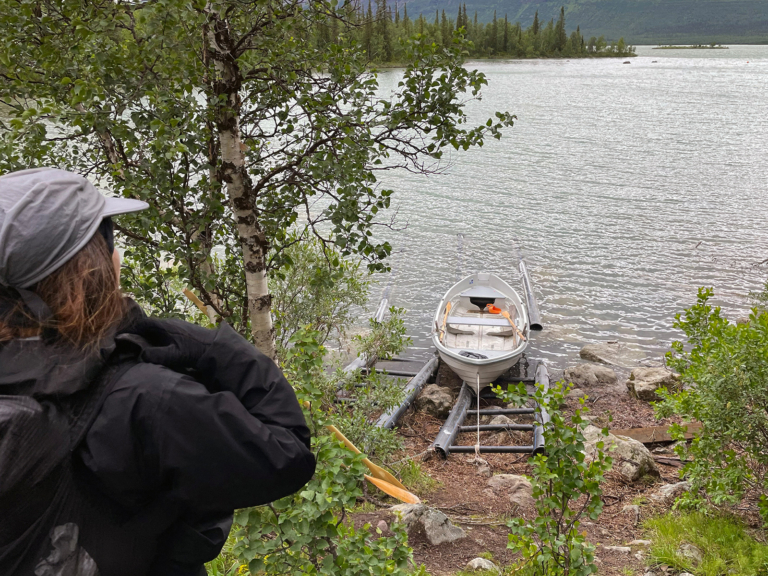
The Kungsleden threads its way around (and across) dozens of large alpine lakes, which must be crossed by rowboat.
The Kungsleden, or King’s Trail, runs through Sweden from Hemavan to Abisko: 440 kilometers (273 miles) of alpine tundra laced with hulking peaks, birch forests, streams, tarns and huts. I was here for vacation, but I’m an R&D designer, which means every trip to the mountains is also an opportunity to experiment. And it just so happened that the Kungsleden offered the perfect mix of conditions for putting a new multiday trail running pack through the wringer: wet and quickly changing weather, ample mileage, big climbs and utterly runnable trails.
Our plan was to run the northern 150 miles of the route over the course of six days. We’d cover roughly 25 miles and 1,500 to 2,000 feet of elevation gain each day, leapfrogging huts, where we’d have a communal kitchen, small dry-goods store, beer, a sauna and a bunk bed waiting for us each evening. So when we found ourselves stranded on the first night, I recognized the irony. From a vacation standpoint, this sucked. From a testing standpoint, it was exactly what I’d come for.
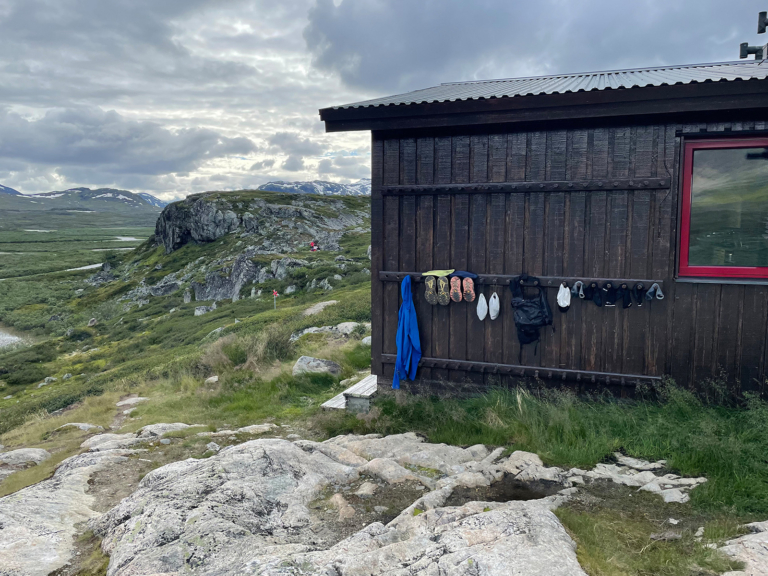
After 20-plus miles of running, a warm hut with a place to dry your gear is a sight for sore eyes (err, legs). The Kungsleden has plenty of them.
When people ask me what I do for work, I tell them I do arts and crafts. After all, that’s really what research and development design boils down to: identifying what doesn’t exist and then making it. Sometimes, athletes ask for things and that becomes the impetus for a project.
Sometimes, a project starts from personal experience. That push and pull between athlete and designer is essential. You have to have athletes that are actively engaged in the process of product creation. But you also have to have your own perspective, your own point of view, to be able to push the conversation further—and to push people further.
This was how my running pack journey began in the first place. In 2019, I got the opportunity to work with Clare Gallagher and Luke Nelson on the High Endurance Kit (a collection of technical high-mountain trail running gear), and through that, developed a relationship with Luke. Over the years that followed, he encouraged me to explore my own boundaries on the trail. I got interested in overnight running and decided I wanted to build something for overnights and something that would help me blur the lines between running and alpine scrambling. So, I started tinkering—expanding the volume of our existing running vests, figuring out how to design the shape and pockets so that they’d hold more gear without bouncing, adding attachment points for trekking poles and ice tools. Once I had an idea and some rough prototypes, I pulled in Luke because he’s at the forefront of that space. Two years of testing and iterating followed. In 2022, the Slope Runner Exploration Pack came into the world.
But as is so often the case in R&D, endings are an illusion. Everything is an evolution.
Right around the time that the Slope Runner Exploration Pack was wrapping up, some friends and I went on a five-day running trip on the John Muir Trail. We ran semi-supported, meaning that we only carried one to two days’ worth of food and gear, and relied on crew support and resupply boxes that we’d stashed along the route.
Wildfire conditions ultimately turned us around partway through, but the trip sparked an idea. I wanted to come back fully unsupported, carrying everything I’d need for the route. I returned to the ideation phase, this time to build an entirely new overnight run kit—including a different pack.
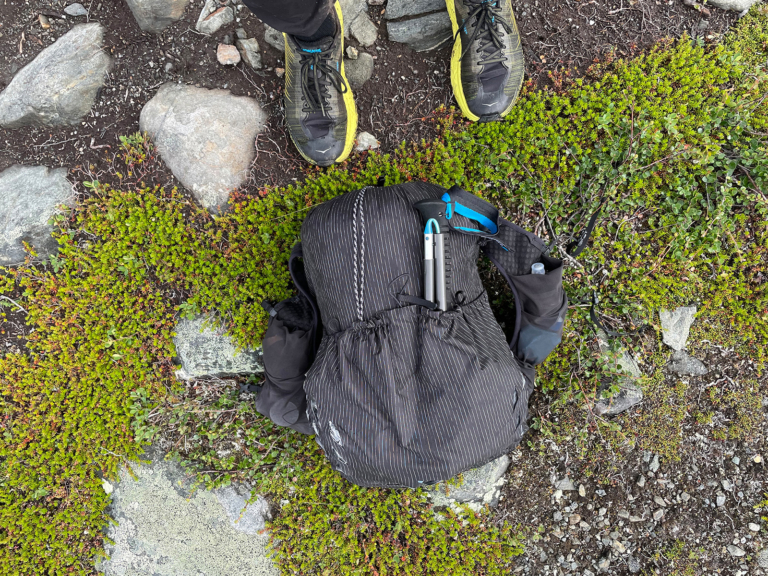
Eric knew he wanted his new multiday running pack to be simple and yet hold everything he’d need for four days on the trail.
The Slope Runner Exploration Pack was great for single big days. But it didn’t have the shape or details I wanted for multiday unsupported runs; its features were more oriented toward a running/climbing crossover rather than a running/fastpacking crossover. I wanted to figure out, what’s the limit of how much you can run with and still feel free in the mountains? How many days can you run unsupported?
I knew what the pack needed to do. I knew I wanted something around 20 liters, enough to fit two to three days of food plus an ultralight bivy kit. I knew I wanted a wide top opening, to make it easier to pack and unpack my kit at the beginning and end of each day. I knew I wanted it to be stripped back, with only the essential pockets or features. The internal organization would come from small stuff sacks and an expandable exterior pocket for quick access, plus a few extra liters of storage if need be.
But I didn’t know what it was going look like. I tend to let that come to fruition along the way, through the iterations—the process of building a prototype, trying it, rebuilding it, then trying it again. I don’t draw pictures; I start with features and function, build the product to fit what I need and let the looks emerge naturally from that process over time.
When I start making a prototype pack, it’s always a muslin build: plain cotton fabric, no features, no anything. At this stage, you’re just trying to figure out the shape and dial in how the pack rides. You want it to sit high enough on your back so it won’t hinder the range of motion. Then it’s time to build a version of it with technical materials.
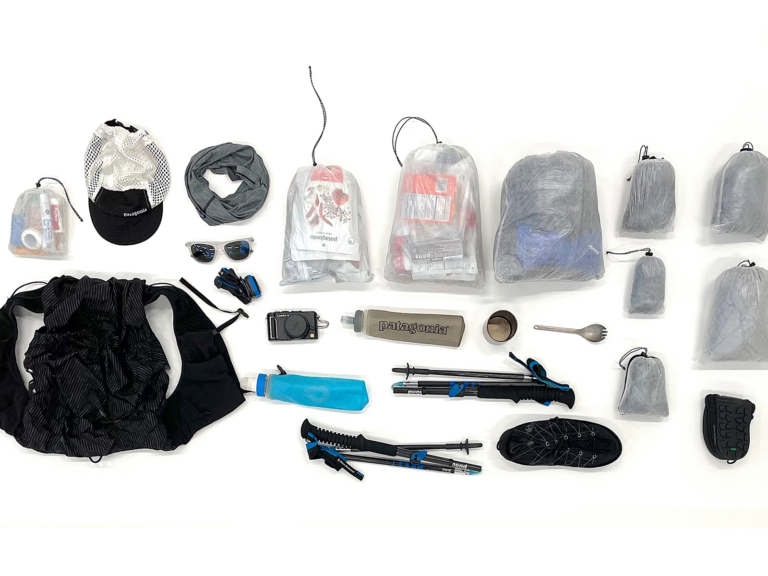
The pack prototype had minimal pocketing. Instead, Eric used Dyneema stuff sacks to organize his gear—clothes, layers, extra food, water, and an ultralight overnight kit.
In this case, I built a working prototype based on the chassis of the existing Slope Runner Exploration Pack. I just added a bit more volume up top, then stripped away features and made the whole pack body a single tube. I also wanted to create an outer pocket that could expand or contract. On multiday trips, your load is constantly changing as you eat food and shed layers. This way, you could add more gear to the outside of the pack without changing how it fits while running.
Then came the refinement. Sure, I could add a pocket made of mesh, but could I do it out of a more durable woven material? What kind of woven fabric would I need? And how would I tweak the design for women? Women’s packs are typically smaller (to fit smaller bodies) but need to hold the same amount of gear. I’d need to change the shape or materialization of the outer pocket to maintain cargo capacity within a smaller footprint. I did a lot of quick studies, laser cutting and just tearing things up to see how different fabrics worked. In total, I made three full builds of the pack, plus five versions of the outer pocket.
I could have kept iterating on the pack endlessly. Since we don’t have firm timelines in the R&D world, I use trips as deadlines. In this case: a friend’s wedding in Sweden. For years, Luke had been telling me I had to check out a route in the Swedish alpine called the Kungsleden. A well-appointed hut system meant the route was far from unsupported. But its remoteness and fickle weather were a perfect testing ground.
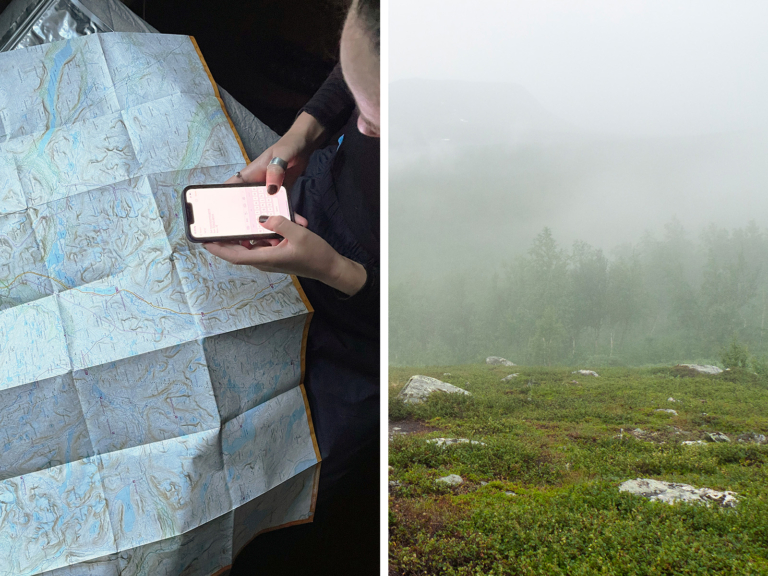
A thick layer of mist obscures the Kungsleden’s massive peaks, but the topo map tells all.
On July 13, Dani and I left our luggage behind at a hotel in Stockholm and set off for the train station, our newly minted running packs stuffed with the gear we’d need to get us to Kvikkjokk, through 150 miles on the trail and then back to Stockholm again.
I remember being nervous when we started. Neither of us knew what we were getting into. As it turns out, the excitement and meditation of a very long run are universal. Despite our unplanned bivouac on night one, morale quickly rebounded as we settled into the rhythm of the trail. Gradual topography made the mountains impressively runnable, while the cumulative vert, cold rain and miles-wide lake crossings in between made them feel huge. Everything was saturated: the air, the ground and, before long, our socks and clothes.
As birch forest opened up into mountainous tundra, we were constantly in and out of rain jackets (and in and out of our packs), fine-tuning our systems, taking mental notes of what worked well and what didn’t. We’d coast across rolling valleys and then work our way up into low clouds. Down below, water crawled across the tundra like an inland fjord—blue-gray veins against green and burnt-orange skin. This was truly the middle of nowhere.
By our third day on the trail, we’d fallen into a groove. Our systems were dialed, and our bodies had caught up with the mileage, so the route flowed by smoothly. Each day boiled down to a simple routine: wake, eat, clean the dishes, run, boat, run, swim, sleep, repeat. Everything suddenly seemed fluid.
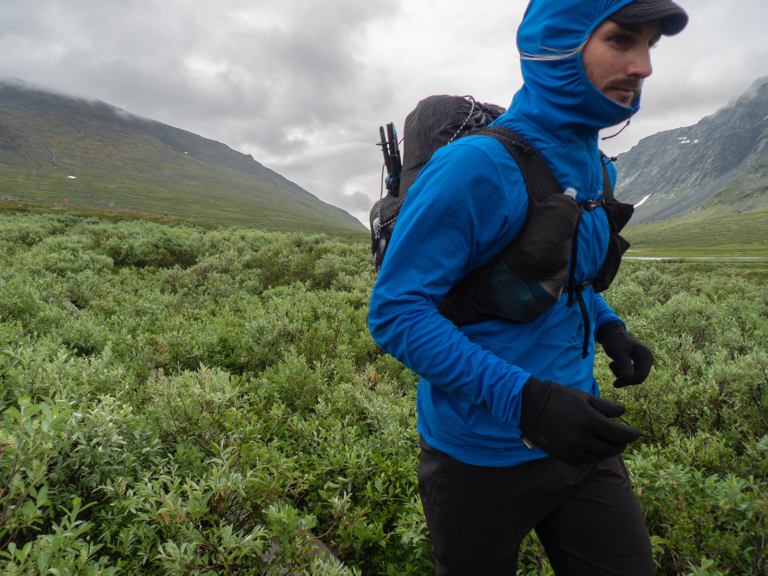
Gloves on, hood up. After just a few days, Eric had the Swedish alpine running uniform dialed.
I used to think you could only find that feeling on a weeks-long thru-hike. I’d thought the only way to run multiday was to rush past the scenery, robbing you the experience of joy. In some ways, I’d built this pack hoping to prove myself wrong—hoping to strip away just enough stuff to attain the freedom of running but without pushing myself to misery or bonk. In doing so, I found a beautiful sweet spot between moving quickly and having all the time in the world.
I think of R&D projects like photographs. Every time I make a piece of gear or clothing for a trip, I’m capturing a moment in time. For me, this pack captures that moment on a multiday trip when reality fades and the flow state kicks in. Whether you are running or hiking does not matter. It’s about being truly unencumbered on a long trail—feeling free, moving efficiently, finding rhythm and ease.
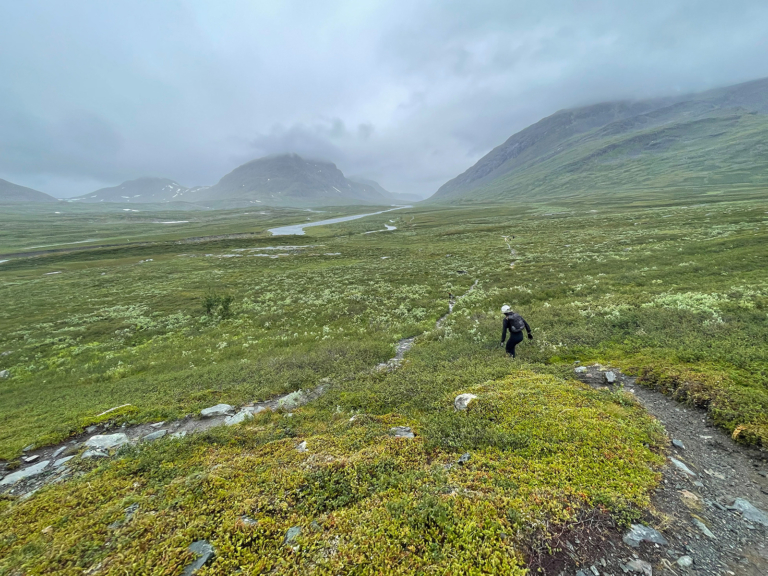
Miles behind, miles ahead. There’s a beautiful moment that happens midway through a very long run where everything suddenly feels simple.
We don’t get too many endings in R&D because we’re creating concepts instead of products. You can always make something better, always do it again. Sometimes, the things we make never even wind up in the real world. In that sense, our last day on the Kungsleden was beautiful and satisfying. We charged through the final few miles, energized from our time on the trail and eager to get back to civilization, arriving in Abisko to the fanfare of colorful flags and music in the town square. It felt nice to finish something. I soaked it all in while my mind quietly wandered toward the next big project, ready to start all over again.
Editor’s Note: This story was written in partnership with the Forge—Patagonia’s research and development lab—to give an inside look at our innovation process. Not all Forge projects make it into the lineup of products you see on our site and store shelves. In fact, many do not. Will the prototypes discussed here make it into the real world? We honestly don’t know! We simply hope this story gets you fired up to tackle some multiday adventures of your own. In the meantime, we’ll be back at our sewing machines, tinkering away.
